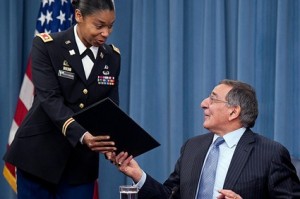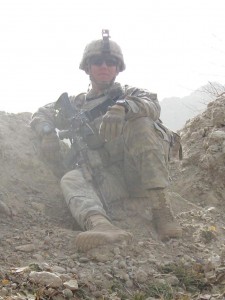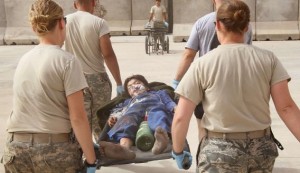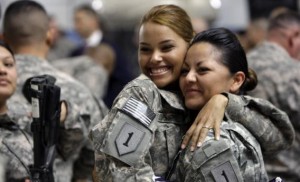Women in Combat: Potential for Progress in the Armed Services
By Kalen Young, with Joshua Young
As a feminist, mother, partner of an infantry officer, and human rights scholar, I was perplexed when Defense Secretary Leon Panetta cleared military services to expand all positions, including combat, to women. Perplexed, as I didn’t quite know how to feel about it. Was this a hopeful move for women? Or detrimental to feminism’s aims?
I began writing this article and found myself stumbling over my thoughts and, in many cases, directly contradicting myself. I wrote my partner an email with my raw thoughts in the hopes that our dialogue might assist me in developing a more coherent response. Currently deployed to Afghanistan on his second tour of duty, my partner is a combat Infantry Officer. Our communication is limited only to email and an occasional phone call, about once every three weeks. We cannot Skype or iChat like many other service members during deployments. This is because the Infantry takes Josh to isolated and volatile areas. His responses to my email were not immediate, as he had to write between operations. But the slowness of our communication permitted both of us time to allow our responses to marinate. This article is the collaborative product of our email exchange.
 On January 24, 2013, Defense Secretary Leon Panetta lifted the ground combat exclusion policy. This policy was established in 1994 and states that “Service members are eligible to be assigned to all positions for which they are qualified, except that women shall be excluded from assignment to units below the brigade level whose primary mission is to engage in direct combat on the ground.” According to former Army Regulation, women could be assigned to any position or specialty “except in those specialties, positions, or units (battalion size or smaller) which are assigned a routine mission to engage in direct combat, or which collocate routinely with units assigned a direct combat mission.” A brigade is usually comprised of 3,500 service members broken down into battalions consisting of 800 service members who are then broken down incrementally. The assumption is that the brigade level is the farthest removed from direct combat.
On January 24, 2013, Defense Secretary Leon Panetta lifted the ground combat exclusion policy. This policy was established in 1994 and states that “Service members are eligible to be assigned to all positions for which they are qualified, except that women shall be excluded from assignment to units below the brigade level whose primary mission is to engage in direct combat on the ground.” According to former Army Regulation, women could be assigned to any position or specialty “except in those specialties, positions, or units (battalion size or smaller) which are assigned a routine mission to engage in direct combat, or which collocate routinely with units assigned a direct combat mission.” A brigade is usually comprised of 3,500 service members broken down into battalions consisting of 800 service members who are then broken down incrementally. The assumption is that the brigade level is the farthest removed from direct combat.
The ground combat exclusion policy was one of the last vestiges of federal law that unequivocally excludes women from important service opportunities based solely on the fact that they are women. This policy was another example of antiquated conceptions about the role of women, their capacities, and where they should be situated within the military. The initial response to the banning of this policy is one of applause. Facially, this seems like a victory for women as it represents the dismantling of a federal policy that represents inequality and deep-rooted sexism. The policy limited servicewomen’s opportunities to serve in certain capacities, limited their access to specific combat schools, and excluded women from the same recognition and promotion that servicemen enjoy—simply because they are women. By dissolving the combat exclusion policy, women now have access to opportunities once denied them based solely upon their sex. Furthermore, rescinding the combat exclusion policy will open approximately a quarter million jobs to women. All of these results would appear to be a victory for women and a progressive step forward.
Upon closer examination, however, the picture that forms does not embrace the same triumphant, progressive pretense. This victory is symbolic, and may turn into either a great victory or a hollow one. Yes, lifting the ban is a vital step in providing equal opportunities to women in the Armed Forces, but the individual services are allowed the leeway to develop distinct plans and apply these as they see fit. The small print is that services may still bar women from specific branches, but now they must provide justification to the Department of Defense. If senior leadership applies sufficient political pressure, then the broader military leadership will pay obeisance to that will. Not because they are crusaders for justice, but because they have their own professional and political agendas. This lies entirely in the Secretary of Defense’s hands. If outgoing Panetta and/or nominee Chuck Hagel demand, “Do this or I will crush your dreams of promotion and receiving more stars on your uniform,” then women will have the opportunity to be fully incorporated into every branch. If our government does not have the courage to hold our generals accountable, we will witness a tremendously hollow victory.
Captain Joshua Young, a U.S. Army Officer currently serving in a combat zone in Afghanistan, noted that Panetta’s decision situates the Armed Forces at the goal-line, but does not guarantee that equal access, equal opportunity, and equal recognition will prevail. Only after the Armed Services have fully integrated each branch will this be a victory.
Let’s also acknowledge that women already have a presence in combat roles. The notion of the ‘front line’ is not clearly defined, especially with Operation Enduring Freedom and Operation Iraqi Freedom. Women may be serving at the battalion level as medics or intelligence officers but are drawn into a ‘kinetic event,’ or a violent attack on troops, with ground combat units. Women medics are not attached to infantry units as such, except as Female Engagement Teams, and those teams are only applied in a low-intensity area where operations are more geared towards ‘nation building.’ This does not remove women wholly from direct combat. Unlike their male counterparts, however, women who serve as such are unable to earn the coveted “Combat Infantry Badge” (CIB) for their roles during active ground combat. Women have the opportunity to earn an equivalent badge for their particular occupational specialty, but these do not hold the same prestige or recognition as the Combat Infantry Badge.
The infantry is considered the crown jewel of any armed force, and always has been. A nation can be bombed, its infrastructure crippled, and brought to its knees with cyber-attacks that destroy command control systems, economy, and tele-communication networks. But the subjugation of an “enemy” cannot be accomplished without boots on the ground. Wars cannot be won without infantrymen. War is an extension of politics by other means, and infantry units are the executors of the last 100m of American policy. Accordingly, the massive U.S. military machine often succeeds with nothing more than infantrymen with weak logistical systems, not air support. This is how important the “grunt” is to the military as a whole. Women have long been denied access to this critical component of military service.
Living in a military environment, it is not uncommon to hear the drone of hoary rhetoric espoused by other infantrymen arguing that women would significantly change the dynamic and camaraderie during a combat deployment. After siphoning out the sexism and ignorance of such commentary, a token of truth about unit cohesion remains. An undeniable bond is forged after a group of servicemen survive the crucible of combat. The presence of women in a combat unit may influence how these bonds are forged, their presence may change the unit dynamic, and it may interrupt unit cohesion. But only if the current military culture remains stagnant.
The entire military complex is predicated upon a hierarchical system that formalizes (and rewards) inequality. It is constituted on a rank system subordinating some and then funneled into a caste system of enlisted and officers. The very architecture of the military is based on the notion that a rank hierarchy serves an important function, and this is coupled with a patriarchal culture embedded in its foundation. The integration of women into combat roles will not completely dissolve the sexism or patriarchal milieu of the Armed Services. Nor will it change the fact that the Armed Services are an extension of the Sovereign and execute imperialist political agendas with lethal force. Amalgamating women into combat roles further incorporates women into the military-industrial complex. The mere opportunity to be incorporated, however, has the potential to disrupt and challenge longstanding pillars that preserve inequality and uphold bigoted justifications of segregation. This potential may be thwarted if the politicization of Panetta’s decision manifests in hasty, uncalibrated movements of women to combat roles as merely a political display of progress.
A meaningful victory will require that women become fully integrated and fully supported. In the staunchly hierarchical structure of the U.S. military, complete integration is yoked to the general staff whose orders, actions, and rhetoric will trickle down to the lower echelons, which will then presumably toe the line accordingly. The Armed Forces may start out integrating combat units because “big brother” told them to, but once women are allowed the opportunity to demonstrate their professional prowess, the Armed Services may well grow into a more mature organization that accepts integration as a matter of fact. Full integration also requires that women be given the requisite training for combat roles.
In order for this decision to move past a “social experiment,” as Lieutenant General William G. (Jerry) Boykin (retired) called it, there needs to be adequate opportunity for training and skill development before shifting mid-career servicewomen over to the combat roles as an expedited political move. If women are to become a part of combat units, they deserve the same training and schooling available to their male counterparts prior to entering a combat role. Hasty movements from one MOS (Military Occupational Specialty) to a combat Infantry MOS may result in professional performance that is not representative of women’s abilities. Such a performance would provide significant ammunition for anti-integrationists.
Many anti-integrationists continue to devalue women’s combat abilities while also prescribing archaic and inaccurate assumptions about infantrymen’s responses to women in combat. The prevailing view is that men will “naturally” want to “protect” women during direct fire as opposed to executing the mission at hand. This is then coupled with a cultural and institutional assumption that more trauma is associated with the suffering of a woman during combat. This paternalistic lens seems to repudiate the fact that seeing your brother bleed to death in front of you may also be traumatic. For those on the outside, it is easy to believe that the death of fellow infantrymen is somehow less traumatic because they are men. Yet the reality of watching a brother suffer a life-altering injury or be killed in action is a subjective experience that transcends socio-cultural and socio-political ideologies and norms. With heartfelt simplicity, Captain Young responds to this assumption, “Speaking to the concern over the reaction of a man when a woman gets hurt, I can’t go off of personal experience because I’ve never run into it. I can tell you, however, that it is not a good feeling to see your brothers bleed to death in front of you, and I would imagine it couldn’t get much worse if it was a sister.” The experience is suspended from indoctrination and holds its own trauma.
Whether a brother or a sister, the reality is that ground combat inherently incubates the potential for deep, lasting emotional trauma. The presence of women does not change that. Nor will the presence of women magically unravel years of combat training that have prepared infantrymen to be mission-driven in the face of unfathomable circumstances. The Infantry, for better or worse, is a well-calculated machine that has sculpted methods of training and indoctrination that turn everyday civilians into fierce soldiers. It is arrogant to assume that prescribed gender norms would somehow override that intensive training. In fact, we might argue that incorporating women into combat training and combat roles symbolically congratulates the military complex and its ability to produce soldiers.
There is room here for the claim that rescinding the combat exclusionary policy does not serve equality. Rather, women’s services (and bodies-as-weapons) are being capitalized on and commodified. The Armed Services, as a complex series of training systems, are ambivalent to sex as long as the person participating can complete the tasks assigned. This is not to say that the folks doing the training are indifferent to sex and gender. From this lens, the inclusion of women in combat units is not a move towards equality as much as it is pragmatism. We could even argue that the inclusion of women in ground combat units is yet another manifestation of the all-consuming military industrial complex.
But for those of us who are members of the military and live in military communities, the reality of this decision is quite different. Though we may all be pegs in the military-industrial complex, allowing women to serve in combat units is a progressive step towards equality in our daily lives. The culture of the Armed Services will change. If done with considerable precision and support, women in the Armed Services will become symbols of equality and a changing cultural climate that grants women, finally, the same recognition as their male counterparts.
_____________________________________________
 Kalen Young received her M.A. in Social Justice and Human Rights from Arizona State University in 2011. During her undergraduate career, she was the Director of the LGBTQ Coalition and later worked as a policy advocate for homeless youth initiatives in Washington DC. Currently, she is a contract researcher designing and developing a veteran needs assessment and program evaluation for Arizona State University, mothering two young boys, and plotting her return to graduate school for her Ph.D. Kalen is deeply interested in women’s reproductive health and hopes to return to her M.A. thesis topic, obstetric fistula.
Kalen Young received her M.A. in Social Justice and Human Rights from Arizona State University in 2011. During her undergraduate career, she was the Director of the LGBTQ Coalition and later worked as a policy advocate for homeless youth initiatives in Washington DC. Currently, she is a contract researcher designing and developing a veteran needs assessment and program evaluation for Arizona State University, mothering two young boys, and plotting her return to graduate school for her Ph.D. Kalen is deeply interested in women’s reproductive health and hopes to return to her M.A. thesis topic, obstetric fistula.
 Captain Joshua Amos Michael Young graduated with honors from the United States Military Academy with a B.S. in Leader Development Science and earned his commission as a Infantry Officer in the United States Army. He is an Airborne, Army Ranger now serving his second tour of duty in Afghanistan with Operation Enduring Freedom. He served his first tour of duty with the 101st Airborne and is currently deployed with the 1st Cavalry. Joshua’s research has primarily focused on military strategy and multidisciplinary study of leadership in an organizational context.
Captain Joshua Amos Michael Young graduated with honors from the United States Military Academy with a B.S. in Leader Development Science and earned his commission as a Infantry Officer in the United States Army. He is an Airborne, Army Ranger now serving his second tour of duty in Afghanistan with Operation Enduring Freedom. He served his first tour of duty with the 101st Airborne and is currently deployed with the 1st Cavalry. Joshua’s research has primarily focused on military strategy and multidisciplinary study of leadership in an organizational context.






16 Comments